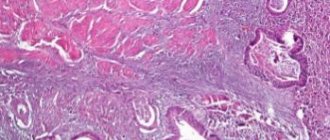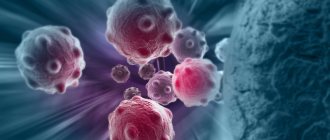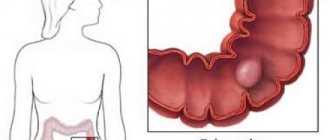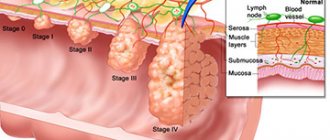Colon cancer is a type of disease that includes cancers of the gastrointestinal tract from the cecum to the sigmoid colon. The large intestine includes the colon, which consists of three sections (ascending, transverse and descending). Oncology of this localization is the third most common type among cancer types, accounting for 15% of cancer tumors.
The second name for intestinal cancer is colorectal cancer. It refers to cancers localized in any part of the colon, but more often adenocarcinomas are formed in the intestines - pathologies of the intestinal walls that produce mucus. This type of disease accounts for 96% of cases. Varieties of oncological pathology, signet ring cell carcinoma and mucous form, have a less favorable prognosis for the patient than with other types of the disease. Intestinal cancer occurs equally often in men and women; gender does not play a role in determining risk groups for cancer.
Classification according to ICD-10
For cancer of the large intestine, the general code according to ICD-10 is C18, the number after the dot is considered to clarify which part of the intestine is affected: C18.0 - cancer of the cecum, C18.1 - cancer of the appendix, C18.2 - cancer of the ascending intestine. Further numbers correspond to the sections of the intestine in order: hepatic flexure, transverse colon, splenic flexure, cancer of the descending section. C18.7 – cancer of the rectosigmoid region. C18.8 is a code meaning several foci of the disease in different parts of the large intestine, and C18.9 is cancer of the large intestine, without specifying the department.
In 40% of cases, the disease affects parts of the colon (ascending, descending transverse), 20% of colon cancer - inflammation in the cecum or rectum. Most often this is a squamous cell type of cancer, and 10% occur in the sigmoid part of the colon.
Cancer is treated in many countries, but the leading clinics in the world are medical centers in Germany, the USA and Israel.
Cancerous tumor in the intestine
Causes
The exact causes of cancer mutations in cells are unknown, but there are a number of factors that influence the chance of developing cancer:
- Age plays a role. An aging body more often makes mistakes in the transmission of genetic information during cell division, and cancer formations appear more often. Most cancer patients are over fifty.
- Poor nutrition and a diet based on fatty fried foods play a role - such food provokes the formation of food carcinogens. This process is controlled by bacteria, which create substances dangerous to human life with carcinogenic, mutagenic and toxic effects from food debris. The risk of getting cancer increases with a lack of fiber in food and excess animal fat. Oncological bowel disease is a disease of meat eaters. Vegetarians suffer from gastrointestinal cancer much less often - plants contain a lot of fiber, which is in short supply in cancer patients.
- Other intestinal diseases that develop into cancer are also dangerous: ulcerative colitis, adenoma, diffuse polyposis, Crohn's disease. Polyps and other precancerous conditions turn out to be ideal soil, ready to interact with carcinogens. When these factors appear, an oncological diagnosis is almost inevitable, especially when it comes to adenomatous polyps. First, polyps form in the rectum, then they rise and end up in other parts of the intestine. A malignant tumor often relapses - a previous disease will most likely provoke a re-diagnosis.
- The reasons include urban living conditions. A person living in a city, especially a smoker, has a greater chance of getting cancer than a person living in a rural area. Carcinoma in the intestine is more often formed in residents of developed countries, rather than in countries with poor economics and industry - this is due to the standard of living and changes in the body provoked by the urban environment.
- In men, metabolic disorders and hormonal imbalances sometimes contribute to the development of cancer.
- The list of causes is complemented by hereditary characteristics - loss of genes as a result of mutations, diseases transmitted by inheritance and many other factors caused by genetic relatedness. Colon cancer in most cases is a consequence of hereditary predisposition. Scientists have identified two genes that increase a patient's chance of getting cancer and are included in the hereditary pathogenesis of the disease.
Symptoms
Cancer of any organ does not appear in the early stages. And colon cancer is no exception. Many manifestations of cancer are symptoms of a nonspecific nature: they appear in other diseases, and it is not easy to determine that a patient has cancer. When symptoms do not indicate the etiology of the disease, diagnosis must be especially careful.
Staged symptoms
At the beginning of the disease, the patient feels a vague, incomprehensible discomfort in the abdomen. The first symptoms are constant fatigue. Gradually, the patient will begin to lose weight, and this is not explained by a deterioration in appetite or a general painful condition. A characteristic manifestation of the disease is mild depression: the patient ceases to be interested in life. A blood test determines hypochromic anemia (a type of anemia characterized by a lack of hemoglobin in the blood).
Further, the symptoms will worsen: patients with cancer suffer from chronic constipation, symptoms of fecal or gas incontinence are possible, food will cause disgust rather than appetite. Blood is visible in the stool - it can be barely noticeable, and sometimes there is a mass of blood of a characteristic scarlet color. An additional symptom is tenesmus - the urge to defecate, painful and frequent, but meaningless.
At the next stages of the disease, the situation worsens: the intestines become obstructed, this occurs in attacks (acute form) or develops into a number of chronic complications of the disease. There is severe pain in the abdomen, the patient feels sick and vomits, sometimes vomiting feces. There is a frequent painful urge to defecate without results.
If the process spreads to the peritoneal area, fluid accumulates there, bloating the abdomen, compressing the abdominal organs with a large mass. The volume of liquid can be impressive (up to 25 liters).
Symptoms of cancer in the right side of the intestine
Symptoms are divided into the right side of the intestine and the left side. The division is conditional, but is based on different reasons. The causes of symptoms due to a tumor in the right side of the abdomen are poisoning of the body and compression of internal organs. And the left side of the abdomen shows a different clinical picture due to the destruction of the tumor and blockage of parts of the gastrointestinal tract. There will be many symptoms of damage to the right side of the intestine by oncology:
- The pain symptom is present in many people with this diagnosis. This is how the first manifestation of the disease regularly responds, attracting the patient’s attention. Dull pain is characteristic of a tumor during the inflammatory process, when new tissue is captured. Severe spasms occur, reminiscent of an attack of appendicitis.
- More than half of patients experience symptoms of hypochromic anemia. The phenomenon is rarely associated with processes occurring in the intestines; in cancer, the levels of occult and visible blood are not always high. Therefore, blood loss does not provoke anemia. Malaise is caused by intoxication, since the contents of feces are partially absorbed into the intestines during oncology and poison the body.
- Symptoms of decreased appetite and general weakness appear less frequently, and the patient gets tired quickly. Weight loss is also rarely a symptom of an illness that prompts people to see a doctor.
- A tumor in the intestine can be felt. But patients rarely do this on their own and turn to doctors - only one out of ten sick people does this. When patients are brought to the hospital with a serious condition, the tumor is usually palpable in three out of four patients. To the touch, the neoplasm is a dense or slightly elastic substance with a bumpy surface. If it is in the transverse section, the tumor is mobile; if it forms in the cecum or in the ascending colon, the mobility of the neoplasm is minimal. When tapping the tumor, the sound is dull; if the back wall is touched, sometimes there is no sound at all.
- Rare signs of cancer, occurring in a small number of patients, are: bloating, flatulence, belching, nausea and vomiting (extremely uncommon). An unpleasant taste in the mouth is rare - it is associated with disturbances in the processes in the stomach and intestines.
- In less than a fifth of patients, intestinal cancer is accompanied by elevated temperature. The manifestation of heat and fever can last a long time, the disease develops in the most dangerous way. For long-term (more than three days) fever of unknown etiology, patients are strongly recommended to check the condition of the intestines with an X-ray or ultrasound.
Symptoms of cancer of the right half of the intestine increase as the disease progresses. As the tumor develops, the signs in the early stages become stronger - from barely noticeable to extremely severe.
Symptoms of cancer in the left side of the intestine
- With inflammation of this part of the intestine, the manifestations described above are not observed. The most common picture is constipation, which cannot be cured either by drug therapy or a strict laxative diet. A patient with cancer on the left side of the intestine complains of heaviness, bloating, flatulence, and rumbling in the abdomen. Symptoms occur in attacks. As soon as a person manages to defecate, all signs of illness stop, then reappear.
- If the cancer has affected the left side of the intestine, the disease does not manifest itself in the form of diarrhea, but alternating diarrhea and constipation may occur due to improper regulation of fluid and mucus in the intestines.
- When the intestinal lumen narrows greatly, an obstruction is formed, but this will not be an acute disease, but will manifest itself in a chronic form - short-term pain from a slight tingling sensation to sudden strong pains, similar to contractions. This means that the passage is not yet completely closed, but the formation significantly impedes the movement of feces. This symptom indicates that extensive inflammation has occurred. But even at the described stage, surgery on the colon is possible.
- Often, when analyzing stool in patients, various impurities are detected: blood, pus, mucus. Blood clots or occult blood indicate that feces are injuring the intestines in the place where the tumor compresses and closes the lumen of the tract. Mucus indicates a malignant process that affects the intestinal walls, and pus indicates an inflammatory process of a purulent nature - an extremely severe form of inflammation.
- Patients often have a bloated stomach - a manifestation due to the fact that gases accumulate in the transverse section of the large intestine, straining the intestinal walls and causing pain.
- It rarely happens that a patient has signs of intoxication of the whole body - fever, weakness, decreased appetite, weight loss and anemia. The described clinic (clinical signs) is not considered sufficient evidence of the presence of a tumor. They may indicate poisoning, poor nutrition and other diseases of the gastrointestinal tract.
Symptoms of pathology in the left part of the intestine manifest themselves as sudden problems with patency, and do not gradually increase, as happens with a tumor in the other half. Early manifestations of a tumor in this location are difficult to catch; most patients discover the tumor in an advanced stage, when their survival prognosis has worsened significantly.
Symptoms by type of cancer
The course of the disease sometimes varies greatly. And any form is characterized by features in symptoms and the course of the disease, which in the future determines a different prognosis and treatment methods.
- If a patient has a toxic-anemic form of oncology, symptoms of poisoning and lack of substances in the blood appear. Signs: fatigue, weakness in the body, feeling unwell. The patient's temperature rises, signs of anemia begin - pallor and pressure changes. The toxic-anemic form of cancer occurs when it occurs in the cecum and in the ascending section.
- If the patient suffers from the enterocolitic form of the development of the neoplasm, then his symptoms go through an intestinal disorder - constipation and diarrhea, flatulence, due to gases the stomach swells and rumbles, purulent and mucous impurities appear in the stool.
- If a person has a dyspeptic form of cancer, the cancer tumor manifests itself in the form of symptoms of functional dyspepsia. An unpleasant heaviness is felt in the epigastric region, the patient suffers from belching, loss of appetite, vomiting attacks occur, the stomach swells and pain occurs - the most acute manifestation of the disease.
- There is an obstructive form of cancer; the main symptom is blockage of the intestinal lumen - obturation. Symptomatically, the disease manifests itself as dull, mild pain in the abdomen, which then becomes severe and aching. The localization of pain is difficult to establish. Then gas retention will appear - bloating, pain and stool retention. The attacks become stronger, then chronic intestinal obstruction forms. If left untreated, the lumen closes completely.
- The last defining form of cancer is pseudoinflammatory. The symptoms are similar to severe inflammation developing in the intestinal area. The patient feels a strong pain symptom in the abdomen, the abdominal muscles are tense and irritated, and leukocytosis and ESR indicators increase. Characterized by rising temperatures.
- In the atypical form, an undifferentiated type of cancer, the neoplasm is palpable, but the rest of the clinical picture (clinic) is blurred.
Colon Cancer Symptoms
Experts identify six sets of symptoms that characterize colorectal cancer.
Minor sign syndrome is a manifestation of tumor intoxication:
- unusual weakness;
- apathy;
- insomnia or, conversely, drowsiness;
- irritability;
- decreased appetite;
- bad breath.
Syndrome of functional signs without intestinal disorders. Usually these manifestations are regarded by doctors as signs of damage to other organs - the pancreas, stomach, bile ducts:
- abdominal pain, the location and intensity of which varies depending on the location of the tumor and its characteristics;
- nausea, belching, vomiting;
- heaviness in the stomach.
Syndrome of functional signs with intestinal disorders. These are manifestations of dysfunction of the colon itself:
- constipation, diarrhea and their alternation;
- copious, watery, foul-smelling stools;
- bloating;
- rumbling in the stomach.
Intestinal obstruction syndrome: stool and gas retention, bloating, abdominal pain and other signs of intestinal obstruction.
Pathological discharge syndrome is the appearance of mucus, pus, and blood in the stool. Usually characteristic of rectal cancer, but can also occur when the left half of the colon is affected.
Violation of the general condition of the patient. These signs usually appear at a late stage of the disease: unexplained weight loss, anemia, symptoms of damage to other organs.
Colonoscopy is the main method for diagnosing colon cancer
Stages
Determining the stage of the disease is the main goal of diagnosis after making the main diagnosis. Priority is determined by the fact that, based on data on the stage of the disease, a prognosis and treatment program are formed. To correctly identify the stage, instrumental and laboratory diagnostic methods are used to help establish the patient’s condition according to three criteria. The main thing in determining the stage of the oncological process is the size of the tumor, the appearance of metastases around it (in particular, damage to the lymph nodes), as well as the presence or absence of metastases in other organs.
The TNM stage classification, based on three main signs of the course of the cancer process, suggests the existence of 4 stages of colon cancer. The classification code consists of three numbers, which indicate the degree and severity of the process sign. The number after T indicates the size of the tumor, the number after N indicates damage to the tissues and lymph nodes closest to the tumor, and the third number after M indicates the presence or absence of distant secondary foci of the disease - metastases.
The first and second stages differ in the size of the tumor. At the third stage, local metastases and metastases form in nearby tissues and organs, and at the fourth stage, secondary foci of the disease appear in other organ systems. This is a standard development of any oncology in the absence of treatment.
- In stage 1 cancer, the size of the tumor does not exceed half the diameter of the intestinal lumen. The early stage means that the neoplasm malignifies the cells of the epithelium and the layer following it, without moving further. The lymph nodes are not affected, and distant metastases do not occur.
- The tumor grows and occupies most of the intestinal lumen. In a different course of the disease, it affects the muscles of the organ. Penetration into tissue and filling of free space occurs in parallel, the spread of the tumor occurs on all fronts. At the second stage, lymph nodes are affected, but only one is the one closest to the tumor, the rest are not yet affected by malignant cells.
Stages of bowel cancer
- At the third stage of the disease, the neoplasm occupies almost the entire lumen of the intestine and grows into new muscles. Near metastases form and the lymph system is affected.
- At the terminal stage of cancer, the tumor spreads throughout the intestine and beyond, forming metastases in nearby tissues and in distant areas of the body. If stage 4 of the oncological process is diagnosed, the disease often affects organs with a lot of lymphatic and blood vessels with a second wave of neoplasms, since through these currents malignant cells invade the body - these are the lungs, liver and kidneys. Through lymph and blood, cancer cells arrive at uninfected organs and accumulate there, creating a new cancer formation, then attacking healthy organ tissue.
Colon cancer stage 4
Stage 4 colon cancer has several stages of development:
- 4A – metastases appear in the lungs or liver, only 9% of patients survive over the next five years;
- 4B – cancer affects not only the intestines, but also lymph nodes throughout the body, as well as a number of internal organs; five-year survival rate is observed in 8% of patients.
As for symptoms, at stage 4 of cancer, all of the above clinical signs are maximally intensified, and the patient’s condition worsens. Treatment at this stage is palliative. Doctors are only trying to prolong the patient’s life and reduce pain and suffering.
Diagnostics
Colon cancer is well diagnosed by laboratory and instrumental methods. The Ministry of Health protocol requires doctors to adhere to the principles of cancer diagnosis, standard methods and the sequence of examinations.
- The first and main diagnostic method, clinical recommendations suggest endoscopy, which can detect the smallest lesions of the large intestine. The study also detects early stages of cancer, and not just large tumors. Often endoscopy is performed with additional staining - the introduction of substances into the body that are harmless, but stain the tissue for a thorough examination. This method, like the next one, is carried out for the prevention of cancer in order to detect the slightest signs of the disease and begin treatment in the early stages. But it is also useful in an advanced state, determining the localization of the tumor and the degree of damage to nearby tissues.
- Colonoscopy also makes it easy to determine whether the intestinal walls are irritated, to find damage, inflammation or neoplasms. A biopsy is taken from suspicious areas of the epithelium and is considered the most accurate way to diagnose the disease. Histological examination of the material shows exactly whether the cell is susceptible to malignant deformation. If there are psychological barriers to colonoscopy, it is done under general anesthesia or virtually. Patients at risk are recommended to undergo regular examinations to exclude the possibility of a cancerous tumor in the precancerous period or at the first stage of the disease.
- An ultrasound examination of the rectum, abdominal cavity and pelvis is performed. This type of study allows you to look at the intestines over time, assess the functionality and degree of damage to the tissues of the intestines and around them.
- Before surgery, magnetic resonance imaging or computed tomography is usually performed to accurately visualize the malignant process. This allows you to accurately plan the course of the operation and build it.
- Diagnosis of distant metastases is carried out using PET - positron emission tomography, which determines the location of secondary foci of cancer. If the metastases are small and begin to develop, they are operated on, preventing the development of the fourth stage of the disease.
- Tumor markers in the blood are a poor indicator for determining cancer; sometimes patients do not even have them at the fourth stage, or they do exist, but in small quantities. They are used to check the patient's condition after surgery in order to track the development of the disease in the period before surgery. When testing for cancer, CEA - carcinoembryonic antigen and CA 19.9 are often used.
Treatment
The main methods of treating oncology are surgical. Irradiation with radioactive waves and chemical therapy are used as auxiliary methods of treatment or as symptomatic treatment to alleviate the condition of a seriously ill person. Radiation therapy is also used.
Surgical intervention
The purpose, method and method of surgical intervention depend on the advanced stage of the disease and the location of the oncology. There are radical operations on the colon, aimed at completely destroying a cancerous tumor in the body, but resection is not always possible. Then a palliative operation is performed, improving the course of the disease, trying to bring the patient with cancer to remission. If the patient’s condition is severe, surgical measures are carried out, which only neutralize the symptoms of the disease or partially restore the functional abilities of the intestine.
There are three types of radical operations: anterior resection, abdominal-anal resection or abdominal-perineal extirpation of the rectum. In three types of surgery, a section of the intestine is excised, including six centimeters in different directions from the inflammation, in order to precisely exclude the possibility of a rapid relapse.
- Anterior resection is performed if the tumor is located more than 12 centimeters from the anus. The area affected by the cancer process is removed, and at the same time another five centimeters are removed down and up the intestines. Then surgical restoration of the integrity of the intestinal cavity is carried out by connecting healthy parts of the intestine to each other.
- If the malignant formation is located 8-11 centimeters from the anus, then abdominal-anal resection with reduction is performed. The sigmoid section of the large intestine is lowered into the small pelvis, the stretched fragment containing the tumor is resected, and then the healthy part is sutured to the anal part of the intestine.
- If the tumor is located less than five centimeters from the anus, the rectum is excised. The sigmoid colon is brought out and sutured under the skin, forming a surgical opening that serves to remove feces. This colon surgery is the most traumatic of the three surgeries, but is necessary if the patient has advanced colorectal cancer.
Colostomy on the human body
- Hartmann's operation is also a forced method of surgical treatment; it is performed in elderly people and patients with diagnoses that prohibit anterior resection. Other indications include intestinal obstruction and thinning of the organ walls, which makes it impossible to stitch together healthy parts of the intestine after removing the cancerous area.
- Various economical operations on the large intestine involve minimal intervention with minimal need to do this - small size of tumors, indications for removal of polyps, early stages of the disease, when only the intestinal mucosa and the submucosal layer below are affected.
- Transanal operations performed through the anus are considered less traumatic. This makes it possible to remove a tumor located close to the end of the rectum without performing a cavity resection, which requires a long period of rehabilitation. This is a relatively new treatment method that has not yet proven maximum productivity and success. It often represents a good solution if abdominal surgery is not possible. After surgery, patients are carefully monitored in the dispensary in case of deterioration or rapid relapse of the disease.
Palliative operations on the colon improve the condition of a patient with cancer of any location and increase life expectancy, but they are not enough to cure the disease.
- They are carried out if malignant tumors cannot be operated on or if the formations disintegrate. Then an artificial passage for feces is created. The sigmoid colon is divided, and the two ends are sutured into the peritoneum.
- If the anus can be preserved, scar structures appear that seriously affect the functioning of the intestines.
Radiation therapy
This treatment involves irradiating the patient with radioactive waves that negatively affect cancer cells, killing them and reducing the size and aggressiveness of the tumor. There are two types of radiation therapy – external and internal.
- In external beam radiation therapy, the patient is placed next to a linear accelerator that emits high-energy radioactive waves. The rays are directed as precisely as possible to the tumor so as not to disturb the nearby tissues, but with the external method of radiation therapy this is almost inevitable.
- With internal radiation therapy, a radioactive drug is delivered directly to the tumor and interacts with it in close proximity, having a fatal effect only on diseased cells and not affecting healthy ones. This is done using local anesthesia and implantation of the drug into the tissue. It is a painless process and faster than external beam radiation therapy.
Radiation therapy is used as an auxiliary method if stage 2 or 3 is diagnosed (then telegammatherapy is used), and as the main method of treatment for palliative therapy, which is often needed in the treatment of the rectum and in the terminal stages of the disease with extensive spread of cancer cells. In the latter case, the method is aimed at improving the general condition, alleviating the pain symptom and reducing the size of the tumor and the inconvenience caused to it. For palliative treatment, small volumes of radiation are used: 50-60 Gy.
Typically, radiation is used in split therapy (dividing the course into three or more approaches). If it is used in the preoperative period to reduce tumor size, the cure rate is higher - 20-30 Gy. After radiation, the results become maximum after two days. Then an operation is performed to excise the malignant tumor.
Chemotherapy
This type of therapy is ineffective for neoplasms in the lumen of the large intestine. It is used in combination with radiation therapy or independently if radiation therapy is contraindicated and surgery on the colon is impossible. The most effective drugs work only in 25% of cases, and polychemotherapy - the use of different drugs simultaneously - does not increase the productivity of the method. Chemotherapy is not used as an adjuvant treatment (excluding metastases and unexcised cancer cells after surgery).
Carrying out a chemotherapy procedure
Laser therapy
The laser method of treating tumors becomes necessary if surgery is impossible, and it is actively used. A neodymium beam is used as an instrument; it is delivered to the tumor and destroys it. The method has a serious drawback - under its influence, the tumor disintegrates uncontrollably, and perforations occur in the intestinal walls. This is dangerous due to complications after surgery. But the method stops bleeding, which is important for cancerous tumors in the intestines. Allows you to restore intestinal permeability and stop bleeding, which seriously improves the quality of life of a patient with cancer.
Postoperative period
- The main task of the doctor is to select the right diet for the patient after surgery. The main point is to normalize the formation of feces, making them dense - it is important that the patient does not experience diarrhea and constipation.
- The patient is selected for drug therapy that accelerates regeneration processes in tissues.
- It is necessary to prevent postoperative complications - the occurrence of colitis and intestinal dysbiosis.
- If a colostomy, an artificial anus, is created during colon surgery, the patient needs psychological help.
- The patient himself needs to monitor his diet in the postoperative period. There are a number of products that are strictly prohibited: carbonated drinks (sparkling water and flavored drinks, beer, champagne), spicy foods (onions and garlic). The patient is advised to eat regular, frequent meals in small portions. Diet is important: the intestines injured by the operation should calmly recover and return to normal functioning.
- Patients with a history of colon cancer should be regularly monitored by an oncologist. During visits, you need to carefully monitor the symptoms that the patient describes, and refer him for examination if a relapse is suspected. Symptoms of relapse include muscle weakness, increased blood in the stool, irregular bowel movements, abdominal pain, especially intermittent pain, frequent bloating and flatulence. During clinical examinations, it is necessary to check the large intestine by palpation, the condition of the lymph nodes and palpate the liver.
Complications of colon cancer
If the tumor blocks the lumen of the colon, the patient develops intestinal obstruction . This condition manifests itself in the form of lack of stool, severe abdominal pain, nausea, vomiting, and severe deterioration in general condition. The patient immediately requires medical attention, otherwise necrosis (death) of a section of the intestine may occur and peritonitis will develop.
If the tumor leads to constant bleeding, anemia develops. The patient becomes pale, constantly experiences weakness, and is bothered by headaches and dizziness. In severe cases, a blood transfusion is required.
Metastasis of intestinal cancer to the liver threatens to disrupt the outflow of bile and develop obstructive jaundice - a condition in which the skin and mucous membranes acquire a yellowish tint, itching, abdominal pain, and general condition worsen. Until the flow of bile is restored, it becomes impossible to carry out active antitumor treatment.
A condition in which cancer cells spread over the surface of the peritoneum is called carcinomatosis , and ascites , an accumulation of fluid in the abdomen. This complication develops in stage IVC colon cancer. Ascites worsens the patient's condition, complicates treatment and has a sharply negative impact on the prognosis.
The European clinic has everything necessary to effectively combat complications of malignant tumors of the colon. In case of emergency, patients receive full treatment in the intensive care unit. Our surgeons perform palliative operations and install stents for intestinal obstruction. For obstructive jaundice, we perform drainage and stenting of the biliary tract. For ascites, our doctors perform laparocentesis (evacuation of fluid through a puncture), install peritoneal catheters, and conduct systemic and intraperitoneal chemotherapy.
For stage IVC colon cancer, when peritoneal carcinomatosis develops, surgeons at the European Clinic use an innovative treatment method - hyperthermic intraperitoneal chemotherapy (HIPEC). All large tumors are removed, then the abdominal cavity is washed with a chemotherapy solution heated to a certain temperature - this helps to destroy small lesions. According to the results of world practice, HIPEC can prolong the life of a cancer patient up to several years.
Book a consultation 24 hours a day
+7+7+78
Forecast
The earlier cancer is diagnosed, the greater the patient's chances of successful survival. When cancer is diagnosed at the first stage, the probability that the patient will live with this diagnosis for five years or more is above 90%. The second stage of cancer suggests a five-year survival rate of 70%. 40-50% of patients live with the third stage of intestinal cancer for about five years or more, but the disease, recognized at the last stage, means that the patient with cancer has little chance of living long: less than 10% of patients survive up to five years with this diagnosis.
Prognosis reports a 65% five-year survival rate among patients with colon surgery. The chances are lower for patients whose lymph nodes are affected by the disease. The likelihood of an unfavorable outcome is influenced by:
- size of the operated tumor;
- damage to the intestinal walls;
- location of the tumor.
If a small tumor is treated, the probability of surviving five years or more reaches almost 90%. If only the epithelial layer of the intestine (mucosal and submucosal layer) is affected, the likelihood of a long and comfortable life is present in 95% of patients.
If the tumor does not affect the lymph nodes, then 70% of patients will have a five-year survival rate. Reduces the chances of the tumor spreading to other tissues and organs - 40% of people survive and live a relatively long time. The higher and further from the cecum and rectum the tumor is located, the greater the likelihood of high patient survival.
Colon cancer stage 2
At stage 2, symptoms intensify. The patient develops the following symptoms:
- blood in the stool;
- pain in the lower abdomen or perineum;
- false urges to defecate become more frequent;
- digestive disorders - constipation, which is replaced by diarrhea and vice versa;
- increased weakness and fatigue.
The neoplasm increases in size and can reach 5 centimeters in diameter. It begins to grow into the deep layers of the intestine and partially closes its lumen.
Stage 2 bowel cancer is treated surgically. During the operation, the tumor is removed along with part of the intestine, after which the surgeon restores the natural patency of the intestine. If the tumor is large or located in such a way that it is not possible to restore intestinal patency, then an artificial outlet (colostomy) is made, to which a colostomy bag is attached. In addition, to avoid metastases, nearby lymph nodes are removed.
The five-year survival rate for patients at this stage is 75%. After surgery, radiation and chemotherapy are mandatory. In addition, the patient is prescribed a special diet, which he will have to follow for the rest of his life.











